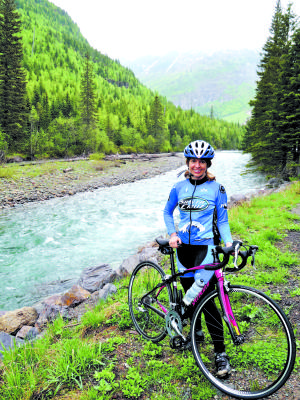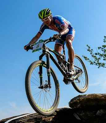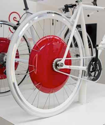By Karen Kefauver
June 22, 2012
 When I told my mom about my plans to visit Glacier National Park in Montana and bicycle the park’s famous Going-to-the-Sun Road, she was happy for me, knowing that I love outdoor adventures, especially ones that involve bike riding. I was excited too, because I’d never been to Glacier. It’s one of the largest national parks in the lower 48 states and is famous for its spectacular mountains, pristine alpine lakes and abundant wildlife. Named for its majestic glaciers (which scientists predict will vanish by 2020) the park also welcomes cyclists.
When I told my mom about my plans to visit Glacier National Park in Montana and bicycle the park’s famous Going-to-the-Sun Road, she was happy for me, knowing that I love outdoor adventures, especially ones that involve bike riding. I was excited too, because I’d never been to Glacier. It’s one of the largest national parks in the lower 48 states and is famous for its spectacular mountains, pristine alpine lakes and abundant wildlife. Named for its majestic glaciers (which scientists predict will vanish by 2020) the park also welcomes cyclists.
But then Mom asked about my Montana travel dates and I started to get cold feet about my visit, planned for the end of May and beginning of June.
“You do realize that when I went to Glacier last July, there was still snow at the park even then?” Mom said, knowing that I am total cold-weather wimp.
Sure enough, while Santa Cruz had been unusually warm and sunny in May, temperatures in the northwest corner of Montana along the spine of the Rocky Mountains were not so balmy, but certainly bearable. Forecasts called for low 50s during the day and rain showers throughout my four-night visit.
I was so pumped about visiting Glacier, one of the country’s top 10 oldest national parks, (established in 1910), that I hadn’t paused to consider that portions of the park could be cold and snowy in the spring.
Feeling slightly less enthusiastic, I abandoned visions of riding in a sleeveless jersey and instead packed wool socks, rain pants and coat, plus layers of warm cycling clothes. After that, I felt more confident that I was properly prepared. Even though I was staying in hotels rather than camping, I wondered whether I would have fun if I would be biking in the rain, since I am spoiled by the nice weather in Santa Cruz.
At Glacier Park International Airport in Kalispell, I met with my four cycling companions. Within 24 hours, we were equipped with Specialized road bikes rented in Whitefish, a resort town with a resident population under 7,000. Whitefish is a convenient recreation hub for those headed to Glacier, which is a 30-minute drive from the town to the park’s west entrance.
Our first stop was the Apgar Visitor Center, the entry point to the Going-to-the-Sun-Road. The plan for our first morning of road riding was to stretch our legs during an eight-mile jaunt from Apgar Village to Lake MacDonald Lodge. It was a chilly, grey day, but as we drove into the park, car loaded with bikes, I saw a heart-warming sight — plenty of parking. For anyone who has visited a national park during peak season, this is a rare treat indeed.
Things got even better inside the visitor’s center; there was no wait to talk to the ranger about the park in general and road conditions in particular. I learned that Glacier National Park is open every day of the year, but that winter weather dictates when most visitor facilities open and close. Peak visitor season at the park is July and August, so my spring trip was firmly in the off season.
“What about recent grizzly bear sightings?” I asked, having just brushed up on my survival techniques at Hidden Moose Lodge bed and breakfast the night before by reading, “Bear Attacks: Their Causes and Avoidance.”
Although spring is bear season, the 600-pound Ursus arctos horribilis was more likely to be spotted on hiking trails than cruising the road, he told us.
The ranger also said that despite the drizzly day, we would likely enjoy the ride on the famously scenic road. And sure enough, he was right.
Riding a well-paved road in a light rain alongside Lake MacDonald on Going-to-the-Sun Road, I marveled at the views of mist-shrouded lake, the largest lake in the park — 10 miles long and 472 feet deep. The glacier that carved the Lake McDonald valley is estimated to have been around 2,200 feet thick.
I had the luxury to ponder these details because there was almost no traffic on the road and it was not a challenging ride; it was mostly flat and gently winding, with lake views along the way. Since my cycling safety is always top priority, it was a delight to have quiet and car-free roadways on one of the most scenic and popular roads in the northwestern United States.
By the time I finished my ride, stopping many times to snap photos of the lake, roadside streams and flowers, I was ready for a hot lunch at Lake MacDonald Lodge, a grand, historic hunting lodge that is cozy with its fireside hearth, yet spacious with its soaring, multi-story lobby decked out in timbers and rustic trappings.
The next day’s ride turned out to be the highlight of the trip. About two million people visit Glacier National Park annually, but it felt like my companions and I were the only ones in the whole park as we pedaled along Going-to-the-Sun Road. We were the only cyclists.
This time, our route started at Avalanche Creek, where the seasonal road closure for vehicles was in effect (save for a few construction trucks that rumbled by loudly and slowly). That meant having the two-lane road virtually to ourselves.
Raindrops dotted my face as I began pedaling at a moderate pace along the famous road that carves 50 miles through the park and winds all the way to the St. Mary’s entrance on the east side.
I wanted to savor the 15 miles and 3,200 feet of car-less climbing toward Logan Pass. The pass itself, sitting at 6,640 feet, the highest point in the park reachable by car, was still not open due to clearing of snow, an incredibly challenging task. There can be up to 80 feet of snow at some parts of the pass. But it didn’t matter that I couldn’t access the pass; it really was all about the trip along the way.
As I slowly climbed my way up, my body warmed up and I actually welcomed the misty rain. I took leisurely breaks and crisscrossed the two lanes to take photos, not having to worry about distracted drivers.
The recent rains swelled the roadside waterfalls and I stopped to listen to the gushing water and savor the quiet. The bike ride,
though relatively short (almost two hours to the turnaround point with stops) was spectacular thanks to the verdant forests on both sides and eventually, the emerging views of the Rocky Mountain ranges as I pedaled higher up the road. I did feel like I was getting in a workout for my lungs and legs and made note to use caution on the way down since the roads were wet and there were some precarious dropoffs. It took only 45 minutes for a rapid descent.
Overall, I felt like I was getting a VIP, behind-the-scenes tour of the park.
As I approached the designated turnaround point, where the road was closed (due to snow plows and construction) my friend Casey pointed out a large, chicken-like bird on the side of the road. My friend continued and I stopped to watch the bird, which was strutting by the roadside, appearing to admire the sweeping views of the valley below. Suddenly, the bird puffed up to
nearly twice its size and displayed its striking finery and I watched in awe at the dramatic makeover.
Turned out the Dusky Grouse is the largest of Montana’s three species of mountain grouse and I got a glimpse of its mating dance. Seeing the grouse in all its finery, alone on the side of the road, made me realize how lucky I was to be among just a handful of cyclists riding Going-to-the-Sun Road that day. What a rare treat it is to go to one of the nation’s finest national parks and experience its treasures while others stay at home, avoiding the rain. Damp in my rain gear, but content beyond measure, I was glad I hadn’t allowed some rain to spoil my cycling adventure.
I would return again to Glacier National Park and aim to arrive when even more of the park road is open to bikes, but before it opens to cars. It is a magical time there and well worth a few shivers.


